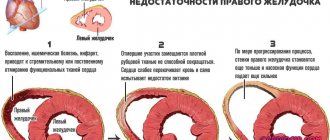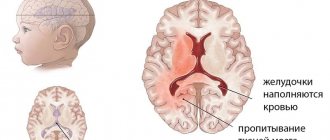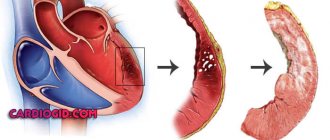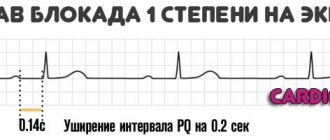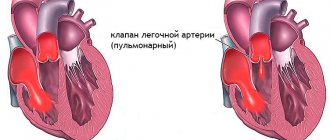The concept of “narrow pelvis”
During the pushing period, when the fetus is expelled from the uterus, it must overcome the bony ring of the birth canal, that is, the small pelvis. The pelvis consists of 4 bones: 2 pelvic bones, formed by the ilium, pubis and ischium, the sacrum and the coccyx. These bones contact each other with the help of cartilage and ligaments. In women, the pelvis, unlike in men, is wider and more voluminous, but has less depth. Normal pelvic parameters play an important role in the physiological, without complications, course of childbirth. If there are deviations in the configuration and symmetry of the pelvis and a decrease in size, the bony pelvis acts as an obstacle to overcoming the fetal head.
In practical terms, a narrow pelvis is divided into 2 types:
- anatomically narrow pelvis, which is characterized by a decrease in one/several dimensions by 2 cm or more;
- a clinically narrow pelvis develops when there is a discrepancy between the size of the child’s head and the anatomical size of the woman’s pelvis during childbirth (but even in the case of anatomical narrowing of the pelvis during childbirth, the occurrence of a functionally narrow pelvis is not always possible, for example, if the fetus is small in size, and vice versa, with normal anatomical indicators pelvis and a large baby, the occurrence of a clinically narrow pelvis is quite likely).
What are limitations in ability to work?
The ability to work, according to Order of the Ministry of Labor and Social Protection of the Russian Federation dated December 17, 2015 No. 1024n “On classifications and criteria used in the implementation of medical and social examination of citizens by Federal state institutions of medical and social examination”, is determined by the employee’s ability to meet the criteria in terms of volume and the content of the work.
People who cannot fully perform their job duties in full, after undergoing appropriate research, receive the right to create special working conditions. The degree of disability is the level of deviation of a person’s physical capabilities from existing norms determined by age.
The imperfections of a citizen as a full-fledged worker include:
- Mental. Disorders of perception of the world, memory and attention, control of emotions, etc.
- Speech. Loss of the ability to verbally and nonverbally communicate, including the inability to fully use oral and written language (dysgraphia, stuttering, etc.).
- Physical. Imperfections of the body structure, including external and internal deformities (deformation of the face or limbs, disproportions of body parts, etc.).
- Functional. Disturbed functioning of the body's systems and organs (circulatory, immune, etc.).
- Sensory. Deviations of the organs of vision, hearing or smell (including exacerbation and dulling of sensitivity under the influence of external factors)
Note! If there is a disease included in the list, each person can apply to a medical institution to obtain disabled status. However, if the medical commission has doubts about the authenticity of the diagnosis, the patient may be required to undergo additional examinations and re-examination.
The law identifies three degrees of restriction on work activity, each involving specific deviations from the norms of a healthy person:
- Persistent disorders of the body caused by chronic diseases, congenital or acquired defects during life that interfere with normal work activity. They entail a loss of the ability to work according to qualifications, but leave the opportunity for general working conditions with a reduction in the volume of production and the severity of labor by at least 2 times. A more rational option, provided for by law, is transfer to lower-skilled activities, which entails primitivization of work and a discrepancy between the level of professionalism and job responsibilities.
- Disturbances in the functioning of systems and organs caused by congenital or acquired illnesses or injuries. Labor activity is possible only with the availability of specialized technical means or with the help of third parties.
- Significant persistent disorders of various etiologies, as a result of which the ability to work is completely lost, including work with the use of aids and the involvement of third parties.
Assigning a degree of restriction on work activity also presupposes the assignment of one of three disability groups, however, an inverse relationship is not provided - disability is not necessarily accompanied by restrictions on work.
Causes
The reasons for the formation of a narrow pelvis differ in its anatomical narrowing or the occurrence of a disproportion between the size of the baby’s head and the pelvic size of the mother.
Etiology of anatomically narrowed pelvis
The following factors can provoke the formation of an anatomically narrowed pelvis:
- disruptions in menstrual function, impaired reproductive function, late onset of menstruation;
- neuroendocrine pathology;
- frequent colds and excessive physical activity in adolescence;
- insufficient nutrition, heavy physical work in childhood.
Anatomical narrowing of the pelvis is caused by the following reasons:
- infantilism, both general and sexual;
- delayed sexual development;
- rickets;
- osteomalacia, bone tuberculosis and bone tumors;
- pelvic bone fractures;
- curvature of the spine (lordosis and kyphosis, scoliosis and coccyx fractures);
- cerebral palsy;
- constitutional features and heredity;
- polio;
- exostoses and pelvic tumors;
- damaging factors in the antenatal period;
- acceleration (rapid growth of the body in length and at the same time a slowdown in the increase in transverse pelvic dimensions);
- stressful situations and psycho-emotional stress, which contribute to the emergence of “compensatory hyperfunction of the body”, which forms a transversely narrowed pelvis;
- professional sports (gymnastics, skiing, swimming);
- impaired mineral metabolism;
- hypo- and hyperestrogenism, excess androgens;
- dislocations of the hip joints.
Etiology of a functionally narrow pelvis
Disproportion in labor between the baby's head and the mother's pelvis is caused by:
- anatomical narrowing of the pelvis;
- large size and weight of the fruit;
- difficulties in the configuration of the fetal cranial bones (true post-maturity);
- incorrect position of the unborn baby;
- pathological insertion of the head (asynclitism, frontal insertion, etc.);
- neoplasms of the uterus and ovaries;
- narrowing (atresia) of the vagina;
- presentation with the pelvic end (rare).
Childbirth complicated by a clinically narrow pelvis ends in 9–50% by caesarean section.
Narrow pelvis: varieties
There are many classifications of anatomically narrowed pelvis. Often in the obstetric literature there is a classification based on morphological and radiological characteristics:
Gynecoid type
It makes up 55% of the total number of pelvises and is a normal female-type pelvis. The body type of the expectant mother is female, she has a thin neck and waist, and her hips are quite wide, her weight and height are within the average range.
Android pelvis
It occurs in 20% and is a male-type pelvis. A woman has a masculine physique; against the background of broad shoulders and narrow hips, there is a thick neck and an undefined waist.
Anthropoid pelvis
It makes up 22% and is characteristic of primates. This form is distinguished by an increase in the direct size of the entrance and its significant excess in the transverse size. Women with such a pelvis are tall and lean, their shoulders are quite wide, their waist and hips are narrow, and their legs are elongated and thin.
Platypeloid pelvis
Its shape is similar to a flat pelvis, observed in 3% of cases. Women with a similar pelvis are tall and thin, have underdeveloped muscles and reduced skin elasticity.
Narrowed pelvis: forms
Classification of the narrow pelvis proposed by Krassovsky:
Forms that occur frequently
- Generally uniformly narrowed pelvis (ORST) is the most common type and is observed in 40–50% of all pelvises;
- transversely narrowed pelvis (Robertovsky);
- flat pelvis, 37%; simple flat (Deventrovxii);
- flat-rachitic;
- pelvis with a reduced wide part of the pelvic cavity.
Forms that are rare
- obliquely displaced and obliquely narrowed;
- pelvic deformation due to bone tumors, exostoses and fractures;
- other forms: generally narrowed flat;
- funnel-shaped;
- kyphotic form;
- spondylolisthetic form;
- osteomalatic;
- assimilation.
Degrees of narrowing
Classification based on the degree of narrowing proposed by Palmov:
- According to the length of the true conjugate (norm 11 cm) and refers to ORST and flat pelvis: 1 tbsp. – less than 11 cm and not shorter than 9 cm;
- 2 tbsp. – indicators of true conjugate 9 – 7.5 cm;
- 3 tbsp. – the length of the true conjugate is 7.5 – 6.5 cm;
- 4 tbsp. – shorter than 6.5 cm, which is called an “absolutely narrow pelvis.”
- 1 tbsp. – transverse diameter of the inlet in the range of 12.4 – 11.5;
- 1 tbsp. – diameter 12.4 – 11.5;
Diagnostics
A narrowed pelvis is assessed and diagnosed in the antenatal clinic, on the day the pregnant woman is registered. To identify a narrow pelvis during pregnancy, the doctor examines the anamnesis, conducts an objective examination, which includes anthropometry, examination of the body, palpation of the pelvic bones and uterus, measurement of the pelvis and vaginal examination. If necessary, special methods are prescribed: X-ray pelvimetry and ultrasound scanning.
Anamnesis
It is very important to pay attention to the diseases and living conditions of a pregnant woman in childhood and adolescence (rickets and poliomyelitis, osteomyelitis and bone tuberculosis, hormonal imbalance, poor nutrition and hard physical work, intense sports activities, injuries and chronic pathology). Obstetric history data are essential:
- how the previous birth proceeded;
- why surgical delivery was performed, whether the newborn had traumatic brain injuries;
- whether there was stillbirth or death of the child in the neonatal period.
Restrictions on work activity for 1st disability group
Until recently, group 1 disability was completely non-working, but in 2020 citizens of this group have the right to work. At the same time, the scope of activity is strongly limited only by mental work.
Note! Citizens who have been assigned the 1st group of disability and the 3rd degree of restriction to work have a note in their individual rehabilitation program about their inability to work. However, if the employer is interested in such an employee, and the disabled person has a desire to work, employment is not prohibited by law.
Options for work activities for disabled people of group 1 are considered from two perspectives: in the first case, the employer undertakes to arrange working conditions for an employee with a disability, in the second, an employee with disabilities fills out an application to accept responsibility for his rehabilitation.
Working conditions for disabled people of group 1:
- Reduction of the working week to 35 hours with full payment of wages, the opportunity to work and less time with the calculation of remuneration based on hours worked.
- The right to refuse business trips, additional shifts and overtime.
- Three calendar months of vacation, one of which is fully paid.
- Organization of the workplace in accordance with the restrictions imposed by the disease (voice control of devices, availability of a ramp for a wheelchair user, provision of an assistant, etc.)
- Strict prohibition on working with chemicals, biologically hazardous substances, at elevated levels of vibration and noise or mental stress.
Objective research
Anthropometry
Low height (145 cm or less) usually indicates a narrowed pelvis. But narrowing of the pelvis (transversely narrowed) is also possible in tall women.
Evaluated: gait, physique, silhouette
It has been proven that in the case of a strong protrusion of the abdomen forward, the center of the upper half of the body shifts posteriorly in order to maintain balance, and the lower back moves forward, thereby increasing the lumbar lordosis and the angle of the pelvis.
The shape of the abdomen is assessed
It is known that in a first-time pregnant woman, the elastic abdominal wall and belly take on a pointed shape. In a multiparous woman, the belly is saggy, since the head is not inserted into the entrance of the narrow pelvis at the end of the gestation period, and the uterine fundus stands high, while the uterus itself deviates from the hypochondrium upward and anteriorly.
- Identification of signs of sexual infantilism or virilization.
- Inspection and palpation of the Michaelis rhombus
The Michaelis rhombus consists of the following anatomical structures:
- above – the lower border of the 5th lumbar vertebra;
- below – the apex of the sacrum;
- on the sides - the posterior upper projections (spines) of the ilium.
Pelvic palpation
When palpating the iliac bones, their slope, contours and location are revealed. By palpating the trochanters (greater trochanters of the femurs), an obliquely displaced pelvis can be diagnosed if they are deformed and stand at different levels.
Vaginal examination
Makes it possible to determine the capacity of the pelvis, examine and evaluate the shape of the sacrum, the depth of the sacral cavity, whether there are bony protrusions, deformation of the lateral pelvic walls, measure the height of the symphysis and the diagonal conjugate.
Pelvis measurement
Basic measurements:
- Distantia spinarum - the segment between the anterior superior projections of the ilium. The norm is 25 – 26 cm.
- Distantia cristarum - the segment between the most distant places of the iliac crests. The norm is 28 – 29 cm.
- Distantia trohanterica - the segment between the trochanters of the thigh bones, the norm is 31 - 32 cm.
- External conjugate - the distance is measured that starts from the upper edge of the womb and ends at the upper corner of the Michaelis rhombus. The norm is at least 20 cm.
- Michaelis rhombus measurement (vertical diagonal 11 cm, horizontal diagonal 10 cm). The asymmetry of the diamond indicates a curvature of the pelvis or spinal column.
- Solovyov index - the circumference of the wrist is measured at the level of the prominent condyles of the forearm. Using this index, the thickness of the bones is assessed: a small index indicates thinness of the bones, and, therefore, a greater capacity of the pelvis. The norm is 14.5 – 15 cm.
- Determination of the pubosacral size (the segment is measured from the middle of the symphysis to the point where the 2nd and 3rd sacral vertebrae connect). The norm is 21.8 cm.
- The pubic angle is measured (normally 90 degrees).
- The height of the pubic symphysis is determined
- The uterus is measured (OB and VDM) to determine the expected weight of the fetus.
Additional measurements:
- measure the angle of the pelvis;
- measure the pelvic outlet;
- if pelvic asymmetry is suspected, oblique dimensions and lateral Kerner conjugate are determined.
Payments and benefits
Depending on the type of disability, a citizen has social security.
Sick leave pays the average salary at the place of employment. The patient retains his position.
Registration of disability entitles you to the following benefits:
- Receiving free qualified medical care.
- Free rehabilitation.
- Preferential drug provision.
- Compensation for housing and utility costs in the amount of 50%.
- Job guarantee.
- Annual paid vacation.
- Shortened working hours for disabled people of the first and second groups.
- Additional payments to Chernobyl victims - liquidators of the Chernobyl nuclear power plant.
- Payment of pensions, benefits, insurance amounts.
Special research methods
X-ray pelviometry
X-ray examinations are allowed after 37 weeks and during childbirth. With its help, the structure of the pelvic walls, the shape of the inlet, the degree of inclination of the pelvic walls, features of the ischial bones, the severity of the sacral curvature, the shape and size of the pubic arch are determined. This method also makes it possible to find out all the diameters of the pelvis, bone tumors and fractures, the size of the child’s head and its position in relation to the pelvic planes.
Ultrasound
Makes it possible to determine the true conjugate, the location of the head and its size, and evaluate the features of head insertion. Using a transvaginal sensor, all pelvic diameters are determined.
How to calculate true conjugate
The following methods are used:
- subtract 9 from the size of the outer conjugate (normally no less than 11 cm);
- 1.5 - 2 cm is subtracted from the value of the diagonal conjugate (for Solovyov index values of 14 - 16 cm and less, 1.5 is subtracted, in the case of the Solovyov index greater than 16, 2 is subtracted);
- according to the Michaelis diamond: its vertical size corresponds to the indicator of the true conjugate;
- according to X-ray pelviometry;
- according to ultrasound examination of the pelvis.
Percentage of disability
The loss of general and professional ability to work is assessed using special tables as a percentage of the initial level of ability to work. The examination is carried out by specialists from the bureau of medical, social and forensic medical examination.
Complete loss is 100% and is registered with persistent dysfunction.
The interval from 70 to 90% corresponds to significant disability. In these cases, it remains possible to perform work only under special conditions.
If the victim works under normal conditions, but with a decrease in his qualifications or intensity, this is a minor degree of impairment, equal to a decrease in working capacity from 40 to 60%.
From 10 to 30% – minimal decrease in working capacity. The victim continues to work in the same place, but with a reduction in working hours.
How is pregnancy progressing?
In the first half of the gestation period, complications with a narrowed pelvis are not observed. The nature of the course of the second half of gestation is affected by the underlying disease, which led to the formation of a narrow pelvis, in addition, extragenital pathology and emerging complications (preeclampsia, intrauterine infection, etc.) influence. Pregnant girls with a narrow pelvis are characterized by:
- the formation of a pointed abdomen in primiparous women and a saggy abdomen in multiparous women, which provokes asynclitic insertion of the head during childbirth;
- the risk of premature birth increases;
- excessive fetal mobility, which contributes to abnormal fetal positions, breech presentation and extensor presentation;
- pregnancy is often complicated by premature rupture of water due to the lack of a contact belt with a high position of the head;
- high position of the head due to the impossibility of its insertion into the pelvis, which causes a high position of the uterine fundus and diaphragm and leads to increased heart rate, shortness of breath and rapid fatigue.
Management of pregnant women
All expectant mothers with a narrow pelvis are specially registered with an obstetrician-gynecologist. A couple of weeks before giving birth, the woman is hospitalized in the antenatal department as planned, where the gestational age is clarified, the expected weight of the fetus is calculated, the pelvis is re-measured, the position/presentation of the fetus and its condition are clarified, and the issue of choosing a method of delivery is decided (a labor management plan is developed).
The method of delivery is determined on the basis of anamnestic data, the anatomical form of pelvic narrowing and the degree, the expected weight of the child and other complications of gestation. Childbirth by physiological means can be carried out in the case of premature pregnancy, 1st degree of contraction and normal size of the child, a mature cervix and in the absence of a burdened obstetric history.
A planned caesarean section is performed if the following indications are present:
- a combination of 1 - 2 degrees of contraction and a large fetus, breech presentation, anomaly of fetal position, post-term pregnancy;
- “old” primiparas, the presence of stillbirth in previous births or complicated births and the birth of a fetus with a birth injury;
- a combination of a narrow pelvis and other obstetric pathology that requires surgical delivery;
- 3 – 4 degree of narrowed pelvis (rare today).
How is the degree of disability determined?
The degree of loss of professional ability to work is established as a percentage. This type of loss is registered when an employee of a certain specialty, after an occupational illness or injury at the enterprise, is unable to further perform professional duties.
The function of determining the degree belongs to the ITU regional offices on the basis of legislative acts of the Russian Federation.
In cases of temporary disability, the degree is assessed by a commission at a medical institution. Includes:
- Deputy Head for Clinical Expert Work – Chairman of the Commission;
- Heads of departments;
- Doctors are specialists.
Pregnancy and pain in the pelvic bones
Pain in the pelvic bones appears after 20 weeks and is due to various reasons:
Calcium deficiency
The pain is constant and aching, not associated with movement or change in body position. It is recommended to take calcium supplements in combination with vitamin D.
Sprain of the uterine ligaments and divergence of the pelvic bones
The larger the size of the uterus, the stronger the tension of the uterine ligaments that hold it, which manifests itself in pain and discomfort when the child walks and moves. This is caused by prolactin and relaxin, under the influence of which the ligaments and pelvic cartilage swell and soften in order to “soften” the passage of the child through the bone ring. To relieve pain, you should wear a bandage.
Divergence of the symphysis pubis
Too much swelling of the symphysis (a rare pathology) is accompanied by bursting pain in the pubis, and it is also impossible to raise a straight leg in a horizontal position. This pathology is called symphysitis, which is accompanied by divergence of the symphysis pubis. Surgical treatment carried out after childbirth is effective.
Stages of arthrosis
Medicine considers arthrosis in three stages. There are a lot of patients who suffer from this disease. Therefore, it is not difficult to establish the degree. The most important thing is not to confuse the symptoms. Arthrosis of the initial stage is characterized by metabolic disorders, the second stage is characterized by injuries and infections, and the third stage is characterized by irreversible changes in the joints.
There are 3 main stages of joint arthrosis
The main reason for the development of arthrosis is physical activity. Physical activity provokes the destruction of ligaments. The recovery process is slowing down. This is provoked by injuries, metabolic disorders, and infections. The main prerequisite for the occurrence of the disease is a metabolic disorder in the cartilage, which reduces its elasticity and regenerative functions, leads to depletion, and disruption of the integrity of the surface. The next stage affects the synovial membranes. Ligaments, tendons and associated soft tissues are affected.
The main causes of the disease are: excess body weight, hypothermia, physical overload, vitamin deficiency, and hereditary factors.
The degrees are distinguished based on the signs of the disease. Zecker's X-ray classification helps specialists determine the stage and degree of osteochondrosis. Without X-ray data, it is incompetent to determine the degree of osteochondrosis.
First stage
Minor changes are the least dangerous. Turning and bending are accompanied by pain, and compaction of the intervertebral discs appears. They appear with sudden movements and soon disappear.
The first degree of osteochondrosis appears when the intervertebral disc suffers from overstrain or ruptures from sudden movement. At first, there may be a sensation of electric current passing through the spine (lumbago), and tension in all muscles.
Tissue swelling also appears. Osteochondrosis of the 1st degree of the lumbar region does not require urgent treatment.
A static position, for example, sitting, or prolonged incorrect posture at first simply leads to sprains. To relieve symptoms, you can take a specialized course and change a simple mattress to.
Therapeutic can be a lifesaver due to its ability to increase the elasticity of muscles and discs. Exacerbations can be relieved with the help of topical medications and analgesics.
However, you should definitely consult a doctor if you notice signs, as it can cause complications. Osteochondrosis, almost harmless at that stage, will move into the second stage.
It is best to go to the doctor and, after making a diagnosis, consult and follow the recommendations in the fight against the disease.
Second stage
Stage 2 is characterized by constant pain during exercise, which gradually becomes chronic. Most often, the disease occurs as alternating periods of exacerbation and remission.
Patients with this degree generally complain of pain in the gluteal region and sacrum, passing through. These signs are similar to those of intervertebral disease.
As a result of the disease, the lumen of the intervertebral discs decreases. This leads to specific pain and numbness of the limbs and. The main cause is considered to be destruction of the fibrous ring and pinched nerves.
This cannot be done without medical intervention. The drugs used are antihistamines and those with a high calcium content. Calcium-containing preparations are needed to restore bone tissue.
Additional methods of struggle are and. Of course, all procedures must be carried out by a specialist with appropriate education.
Third stage
Symptoms of a herniated intervertebral disc indicate stage 3 osteochondrosis of the spine. These are pains that lead to nerve damage in the legs, and the gait of the sick person often changes.
In some cases, disharmony in the sexual sphere is diagnosed. The symptoms are pronounced.
This is the degree that is considered dangerous and difficult to treat. Here the fibrous ring is completely destroyed, and its fluid fills the space between the vertebrae. The result is low mobility.
The worst consequence is the patient’s disability due to complications. Therefore, the right solution would be surgery in combination with.
The fourth degree of osteochondrosis indicates that the vertebral bodies grow and damage the nerves of the spinal cord or completely block the spinal canals.
There are cases of compression of the spinal cord, in this case they speak of spinal cord ischemia.
Doctors also include the consequences of surgical intervention to this degree. That is, destruction spreads to organs and structures near the vertebrae.
Some patients are interested in when they are diagnosed with osteochondrosis from 4 to 6 - what does this mean? This diagnosis suggests that the intervertebral disc between the 4th and 6th vertebrae is squeezed slightly forward. They control the functioning of almost the entire body. Symptoms include nagging pain in the shoulders and lumbago.
Thus, no matter what degree of pathology you have, remember - each of them is dangerous to health. Be sure to consult a doctor, follow all his instructions and do not self-medicate.
The information in the articles is for general information purposes only and should not be used for self-diagnosis of health problems or for therapeutic purposes. This article is not a substitute for medical advice from a doctor (neurologist, therapist). Please consult your doctor first to know the exact cause of your health problem.
I will be very grateful to you if you click on one of the buttons and share this material with your friends
